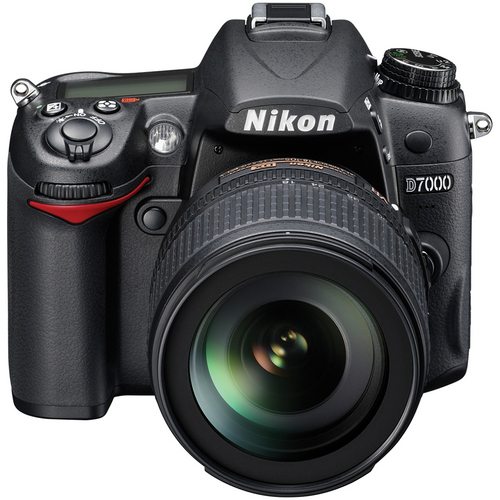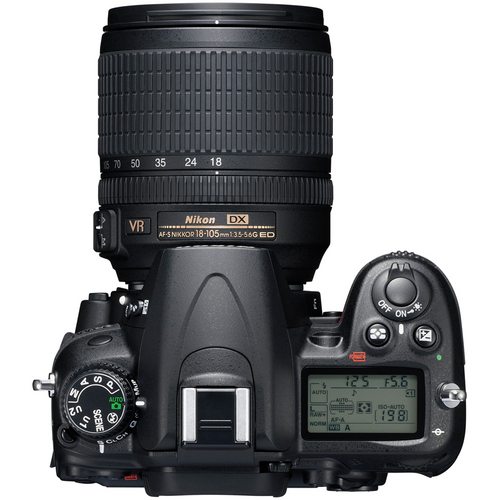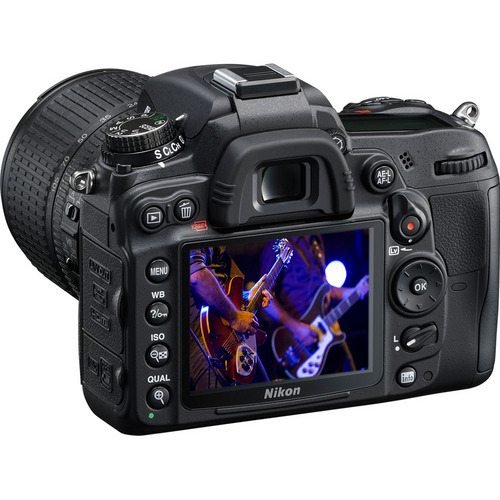I’ve enjoyed spending time with our new Nikon D7000. It’s a great camera with a thoughtful and innovative feature set. It is thoroughly capable and easy to operate. Nikon has used the camera to start a new naming convention and also to introduce a couple control layout changes that show this is a carefully designed offering from the company.
The current Nikon lineup, per Nikon USA’s Webpage, includes nine DSLR cameras (at the time of writing this):
The Nikon D3000 ($550), The Nikon D3100 ($600), The Nikon D5000 ($630), The Nikon D90 ($950), The Nikon D7000 ($1,200), The Nikon D300S ($1,500), The Nikon D700 ($2,350), The Nikon D3S ($5,200), and The Nikon D3X ($7,600)
Nikon has a history of running seemingly overlapping products simultaneously. Perhaps the company’s habit of perpetual backorder leaves an abundance of products once replacements are announced. This new camera, though, is not an obvious replacement for the D90 or the D300S. It’s both a bit more camera than the D90 and a bit less beefy than the D300S. Nikon has gradually been building a consumer/enthusiast “D#000” line, defined as crop-sensor “DX” cameras without the rugged magnesium alloy frames of the pro “D#00” or “D#” lines and, for as long as Nikon keeps the three lines intact, the D7000 will be the company’s top enthusiast camera, offering the majority of Nikon’s pro imaging abilities in a more portable and friendly package. And in that category, it is very good.
I’ve taken it with me to a number of professional shoots, shooting alongside my faithful D3. I’ve also enjoyed toting it to parties, T-ball practices, and playgrounds. In most settings, it’s a fun camera to use and is capable of excellent results. We’ll be digging in deep over the next 5 entries!
Editor’s Note: Chris reviewed the D300s, D3x, and D3s.
Tech Specs
The D7000 has a 16.2 MP DX sensor (DX = “cropped” in Nikon nomenclature), shoots 1080p HD video, RAW and JPG files to dual SD/SDHC/SDXC card slots. It has a 3″ fixed LCD screen, a pop-up flash, and standard hot shoe flash mount. For autofocus, it uses a 39 point system that can be set for single, continuous, or a new automatic setting. The autofocus points are indicated in the camera’s viewfinder with a bright overlay descended from Nikon’s pro line and the camera, like the D90, can make full autofocus use of Nikon AF lenses with or without internal motors. The camera has a dedicated live view control that can be activated from any exposure or drive mode, once in live view, video recording is started with a dedicated button.
Ergonomics
The Nikon D7000 will feel immediately familiar to Nikon shooters. Though tough, it is not a solid brick like the D300S or D700. Compared to the $300-more D300S, it has less rubber gripping, less obvious moldings for thumbs and fingers, and is slightly smaller. By that comparison, ergonomics suffer. By another comparison, the smaller, but also pricier Pentax K-5 we reviewed last month offers a more contoured and comfy grip.
That aside, though, the D7000 hits a very nice balance between robust build and easy portability. It is noticeably lighter than bigger Nikon’s and yet offers enough room for a steady grip. Its plastic parts are nicely textured with Nikon’s familiar splatter paint black on black and no element of the camera feels flimsy or out of place. I prefer its firm, chunky exposure mode dial to the relatively flimsy and frustrating version found on the Pentax K-5. All considered, the D7000 is a sturdy and satisfying-feeling camera with a clean and purposeful design.
Button Layout
Here’s where things get interesting with the Nikon D7000. Control layout is one area where the camera really does seem to be splitting the difference between the D300S and D90.
From the D300s, the D7000 takes a dedicated drive mode control. A nicely integrated ring, just under the metering mode dial, selects between Single Shot, Continuous High Speed, Continuous Low Speed, Quiet Mode, Self-Timer Mode, Remote Control Mode, and Mirror Up Mode. It’s instantly familiar from my D3 and a nice change from the D90’s top panel button. It also borrows the D300s’s playback and trash button placement, adding a touch of stylish molding to set them out.
From the D90, the camera takes its exposure mode dial (bigger Nikons all use a mode button/control wheel for exposure mode settings) metering area button, and button placements for White Balance, ISO, and Image Quality (all three are on the top left of the D300S).
To the D90 and D300S, the D7000 adds a great live view/video recording control. The switch/button combo, first introduced, with less style, on the D3100, allows instant easy access to the camera’s live view from any exposure or drive mode. It’s perhaps the first DSLR I’ve used that makes video recording fun and straight forward (including full-time autofocus!) The D7000 also allows clutter free access to AF point selection by way of a button integrated with the AF/M selection switch on the camera’s front. It’s a new, clever way to clean up the interface without burying control in a menu.
What’s Missing?
Like the D70, D80, and D90 and unlike the D300S and pro Nikons, the D7000 does not have an AF button. Autofocus can, of course, be engaged with the shutter release. Many photographers, including myself, enjoy a dedicated control for autofocus, for tracking a moving subject in AF-C or for locking a subject with AF-S before recomposing or waiting for a key expression, gesture, or action. These can be done with the shutter release, also, but the option is nice, and it’s somewhat expected on high-end 35mm cameras.
The D7000 offers a compromised alternative. Its front function button can be set to control an astonishing 20 different functions, including AE-L lock. The AE-L/AF-L button can then be set to AF-on and work just as an AF button on bigger Nikons. For whatever reason, though, setting it that way then deactivates the shutter release button’s half-way press AF engage.
As a cool feature for making these types of adjustments, the easily accessible info screen shows what the two buttons are currently controlling, and settings can even be directly accessed, along with other second tier controls, like Movie Quality, Noise Reduction, and Picture Control, by pressing the info button a second time. As one last note on the AF/Fn/AE-L situation, it’s worth noting that the Fn and aperture preview buttons are in confoundingly-reversed order compared to my D3 and D200.
Why the Metering Area Button There?
Way back, with the D70, Nikon began the tradition of placing the metering area button on the very prominent top panel. This hallowed space, shared with the on/off switch, shutter release, and exposure compensation is a very lofty assignment for something like metering area. Here’s a quick list of other cameras and their selection of which controls are worthy of being grouped with the Shutter Release
Nikon D3 series: on-off-screen light, Exposure Mode, Exposure Compensation
Pentax K-5: on-off-depth of focus preview, exposure compensation, ISO
Leica S-2: Shutter Speed
Olympus E-5: ISO, Exposure Compensation, White Balance, Screen Light
Canon 7D: “Fn”, Exposure Area, White Balance, Autofocus Settings, Drive Mode, ISO, Flash and Exposure Compensation, and Screen Light
It’s interesting to note which controls each camera manufacturer considers to be most important, from the simple purity of Leica to the startling all-you-can-eat buffet approach of Canon. Most companies agree that exposure compensation is a key function. The ballots are split between White Balance and ISO controls for second place. But metering area? This camera has me thinking I should be using it more, but, honestly, I haven’t changed that setting on any of my professional cameras for years.
With a full matrix reading of the scene, you have a good guess at what the exposure should be. Backlit subject? better go brighter. Dark-colored subject? better go lower. When does Nikon want us to switch to spot or center weighted metering? Apparently more often than we’re expected to change ISO. Perhaps in the way Apple Computers must have only one button (think iPad, iPhone, iMac, (i)Mouse) Nikon must group together ISO, White Balance, and Image Quality. Indeed, on whatever Nikon DSLR the controls land, they’re close neighbors.
The three exposure controls are Shutter Speed, Aperture, and ISO. On modern DSLRs, any or all can be controlled by either the camera or the photographer. To demote a dedicated ISO button is to suggest that ISO should be camera-controlled via Auto ISO, which is optimistic of Nikon. To promote metering area? I’ve been thinking about that for a week and can’t bring myself to use it. I might be alone here, please someone post a detailed comment about when and how you use metering area and why you think it deserves the ultimate button real estate next to the shutter release (location location location!)
Autofocus
Oddly promoted auto exposure settings aside, the camera has awesome autofocus. It is closely related to the killer AF of my D3, with many clearly indicated and easy to get to points that quickly grab focus on almost anything, moving or not. The controls are easy to use and the results are dead-on. Autofocus is Nikon’s specialty, and they have held back very little on the D7000. For the rare times with auto point selection can’t make the right choices, the camera’s point selection is controlled by the 4-way rocker with the center button snapping it back to the middle. We’ll go much more in depth in an upcoming entry, including exploring the new AF-A setting and control interface. In the meantime, autofocus is certain to be among this camera’s unique strengths.
Day 1 Conclusion
The stage is set for a fun review series on the very capable Nikon D7000. Nikon has nicely combined strengths from two very well regarded cameras, the D90 and D300S. All combined, the D7000 is a matured, updated, and compelling new take on the Nikon D90, a camera I’ve recommended for years. I enjoy its mix of beefy features and light weight, quick access to key shooting features, and top notch autofocus. Compared to the bigger Nikons, it gives up a certain ruggedness, ergonomic grip, and streamlined button placement, but preserves the straight-forward purposeful design of professional Nikon cameras.
During our series, we’ll explore image quality, location shooting, studio shooting, etc, etc, etc. I look forward to it!
Please Support The Phoblographer
We love to bring you guys the latest and greatest news and gear related stuff. However, we can’t keep doing that unless we have your continued support. If you would like to purchase any of the items mentioned, please do so by clicking our links first and then purchasing the items as we then get a small portion of the sale to help run the website.




